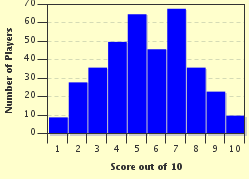Quiz Answer Key and Fun Facts
1. During the Roman occupation of Britain two defensive walls were built. Hadrian's Wall was one, what was the other?
2. When the Romans left Britannia in 410AD the natives were left defenceless. Because of this the country was invaded by raiders from Scandinavia.
3. Less than 100 years after the Norman conquest of Britain in 1066 the country was thrown into its first civil war. Who were the two main protagonists?
4. At the Battle of Falkirk in 1298 which English weapon helped to destroy both William Wallace's army and his reputation?
5. The Hundred Years' War between England and France was initiated by a French desire to conquer and rule England.
6. The Wars of The Roses took place over a 30 year period during the 15th century. Much is known about this period, but do you know how many kings ruled between the start of the wars in 1455 and the end of the century?
7. During the reign of Queen 'Bloody' Mary there was an attempt to return England to Catholicism. Three leading Protestants, Archbishop Thomas Cranmer, Bishop Nicholas Ridley and Bishop Hugh Latimer were burned at the stake in which English city?
8. The Great Fire of London is well documented. Which of the following has NOT been blamed for it at one time or another?
9. During the last quarter of the 17th century English Protestants began to fear a return to Catholicism. They approached William of Orange to come and take over the throne. What name has been given to this period of British history?
10. In 1707 England and Scotland finally became one country with a single Parliament. Who sat on the throne at the time and so became the first monarch of the United Kingdom of Great Britain?
Source: Author
romeomikegolf
This quiz was reviewed by FunTrivia editor
bloomsby before going online.
Any errors found in FunTrivia content are routinely corrected through our feedback system.

